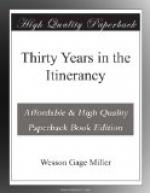But out of one trouble, we were soon into another. We had hardly reached the open lake before the boat encountered a heavy sea, which brought sea-sickness to all of the company for the balance of the journey. But in this misfortune we were not alone. Rev. E. S. Grumley, the newly appointed Presiding Elder of the Racine District, and his family, had also come on board at Sheboygan, and were now our companions in travel, as also in misery. Tossing amid the waves, the progress of the steamboat was slow, and we did not reach Racine until after midnight. We were happy to gain a landing, but we found ourselves without a conveyance to the hotel. Not even the common dray was at hand. But, nothing daunted, we groped amid the darkness until we came upon the buggy of the Presiding Elder, which fortunately had been landed from the same boat. The invalid was soon placed in it, and, adopting a style of travel that might have seemed unusual by daylight, in due time we were at the hotel.
The following morning we were sought out by the good people and kindly cared for, being assigned to quarters with my late host and his obliging family.
CHAPTER XVII.
Racine.—Its Early History.—Subsequent Growth.—Racine District.—Rev. Dr. Hobart.—Kenosha.—Rev. Salmon Stebbins.—Sylvania.—The Kelloggs.—Walworth Circuit.—Burlington and Rochester.—Lyons. Troy Circuit.—First Class at Troy.—Eagle.—Round Prairie.—Hart Prairie.—Delavan.—Elkhorn.—Pastorate at Racine.—Revival.—Church Enlargement.—Second Year.—Precious Memories.
The great centers from which the Church in Wisconsin has radiated were few in number and were fixed upon at an early period in the development of the work. These centers were Green Bay, Sheboygan, Fond du Lac, Aztalan, Racine, and Janesville. Of the first five a record has been made, and, following the line of my labors, Racine should next engage my attention.
At this place the first settlement was made in November, 1834, by Captain Gilbert Knapp, who came on horseback from Chicago. On the second day of January following, Stephen Campbell, Paul Kingston, and Messrs. Newton and Fay arrived, and, as far as I am able to ascertain, were the first Methodists who settled at Racine. At the same time William See and Edmund Weed came to the vicinity, the former settling at the Rapids, where he built a mill, and the latter making a claim on the lands which have since become the homestead of Senator Fratt. Alanson Filer came in November, 1835, and A.G. Knight in April, 1836. In his journey to Wisconsin, Brother Knight traveled on horseback from Wayne County, N.Y., to Chicago, and on foot the balance of the way. Jonathan M. Snow and Nathan Joy came soon after, the latter coming around the lakes in the first three-master that visited Lake Michigan. Rev. Daniel Slauson and William Bull came in September, 1837, traveling in their own conveyance from Detroit. The list of names thus given does not make a full record of the early arrivals, but furnishes, as far as I am informed, such as constituted, with the exception of the first named, the first Methodist Community.




